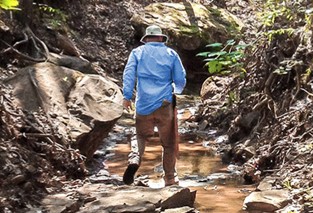Wetlands & Waterways – Navigating Federal Policy under the Clean Water Act
Section 404 – What Is It & Why Is It Important to Your Project?
In 1972, Section 404 of the Clean Water Act established a program to regulate the placement of dredged or fill material into waters of the United States. The program is jointly administered by the U.S. Army Corps of Engineers (USACE) and the Environmental Protection Agency (EPA).
The USACE and EPA are committed to protecting the nation’s aquatic resources while facilitating practicable development through a permitting process. USACE evaluates permit applications for essentially all construction activities that occur in the nation’s waters, collectively referred to as waters of the United States.
When Does Section 404 Apply?
A delineation or juridsictional determination is a useful process conducted by environmental specialists to demonstrate the presence (or absence) of waters of the United States.
Once the delineation process is complete, the following step progression is a helpful guide to determine how to proceed:
- 1a Waters of the United States are not present within the project footprint: Section 404 does not apply. No permit is required and the project may proceed.
- 1b Waters of the United States are present within the project footprint: See 2a and 2b.
- 2a A regulated activity (i.e. fill activity) does not occur in waters of the United States: Section 404 does not apply. No permit is required and the project may proceed.
- 2b A regulated activity (i.e. fill activity) does occur in waters of the United States: See 3a and 3b.
- 3a Coordination with USACE is not required: Section 404 applies, but the project is permitted by rule and general conditions apply. The project may proceed.
- 3b Coordination with USACE is required: The project may not proceed without written verification from USACE.
A member of Halff’s environmental team delineates a stream crossing for a 210-mile pipeline project in central Oklahoma.
Early Involvement Equals Happy Clients:
The authority of any regulatory agency can drastically impact a project schedule if not addressed early. Halff has the expertise to make the Section 404 process a seamless part of the project schedule.
Halff’s environmental specialists are currently engaged in a region-wide utility program in East Texas, where there are numerous perennial streams, forested wetlands, and state- or federally protected fish and wildlife species. To develop practicable alignments while minimizing impacts to natural and cultural resources, Halff’s environmental specialists work collaboratively with right-of-way agents, surveyors, and project engineers.
In fact, Halff has helped establish more than 40 miles of utility alignments to date without the need for USACE coordination under Section 404 (see Steps 1b, 2b and 3a).
Take-Home Thoughts:
Section 404 rules and regulations change from time to time and can be confusing. An experienced environmental/regulatory specialist with a working relationship with the USACE districts can prove valuable.
With proper planning and a collaborative effort between the client and project team, permitting requirements can be minimized if not eliminated altogether, even if waters of the United States are present.
Don’t panic. Even if a permit is required, see Take-Home Thought No. 1 and call Halff.



